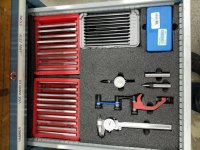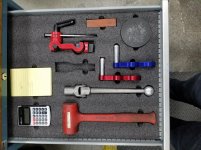New poster here from the UK. Our shop is your typical jobshop, high variety and very low volume work across fabrications, machined billets etc. A lot of made to order 1-10 off, very rare to get anything past 50 off. Size and complexity of work ranging across the whole spectrum as well. The shop has a mix of prototrak knee mills, bed mills and lathes, 3 VMCs, vertical borer, small grinding machines, a jig borer and a wire edm. We have a welding bay for fabrications and an assembly and electrical department which allows us to do more integrated machine or tooling builds/rigs as well as their own standalone work.
For the guys who own or are employed by a shop handling similar work type and quantity, what have been the biggest low hanging fruit type efficiencies you've either seen or implemented in your companies? Can some level of automation apply with this 1-10 off work to leverage the output of each machinist? Just what is the blueprint for an optimised shop catering to this work segment?
Appreciate all input.
We have a very similar shop and workload. Add a couple lathes, a waterjet, a few high end 3d printers, and a CNC pressbrake and you got our shop.
When I first got to this shop 4+ years ago, organization was a complete mess. And my background being purely aerospace, I was used to having my most used hand tools at each work stations. So, I had to change this as not a single drawer was organized. I can still hear the opening and closing of drawers as folks searched for simple things that they used every day.
I standardized every machine with the tools required to operate, setup, and deburr at that workstation. Used kaizen foam and organized the drawers to have very similar layouts between machines types and identical layouts if the machines were identical. Not having to search for 5-10mins for a simple vise wrench, stone, or set of parallels is SO nice. And the fact that the tool has a specific home in a specific labeled drawer helps guide people to put things away or helps them find what they need. Organization of standard workstation tools in any shop is a must.
Tooling is another thing to organize. Vises, cutters, hardware for toe clamps. This for us was all over the shop. I spent about $5k on new drawers for an old lista wall system and consolidated all this stuff into a single area and then organized it. Finding the right cutter or fixture is as easy as it could be. Big time saver there.
When discussing cutting tools in a prototyping shop, there is generally like 1 of every conceivable type of cutter. You get such a diverse variety of jobs and you just collect odd stuff over time. But, that doesn't mean you shouldn't have a Standard tool inventory. Since we work on all materials from metals to plastics to composites, it's hard to really build something that is all encompassing. So, the best we can do is at least have this:
- Drills up to .500" in both machine and jobber length. (maybe 12 or 14mm for you)
- End mills in typical sizes in short LOC and Long LOC. For us thats 1/16, 1/8, 3/16, 1/4, 3/8, 1/2, 3/4. We carry this in both 3fl ZrN for aluminum and 4fl for Steels and such. If you do more plastics I would recommend 2fl or even 1fl for slotting sheet type work.
- Our face mills are the same product line across the board. So, inserts are the same size. We keep uncoated bright inserts for plastic and aluminum, and coated for steels or hard metals.
- Small variety of 2fl and 4fl ball mills in common sizes. We have maybe 20 total on hand. Not super common, but just enough that we know we have something in the drawer if we need a general ball mill.
-Spots, c'sinks(82,90,100)
-Taps in Coarse and Fine, both plug and spiral bott/form. Form for small, spiral for larger than 1/4".
-And standard turning tools following a similar pattern. Sharp for plastic/aluminum, coated for steels and hard metals. A few tool nose radii that make sense to us. A couple thread inserts, profiling inserts, grooving, and part off.
You get the gist.
Just find the most common tools used in your shop and keep them stocked. No point in needing something that may make it to you next day. Anything outside this kit that are only for a specifc job, just order it as you need it. Keep leftovers as anyone would. Or if you're really stingy, you might be able to return unused products back to your Tool Supplier which makes sense on expensive cutters that they may stock and you can't afford to.
Having Trak mills(which we do as well) you're programming conversationally alot. But we also have a CAM system that we can program with and use with the Traks, but it's more often used for our 5x mills, 3-4x haas, and mill turn. Either way, if you have a CAM system to compliment your conversational, its worth setting up your tool library with all the standard tools that you stock. Most CAM packages these days allow for assigning feeds, speeds, and strategies for the tools in the database. If you take the time to build this database up, you can significantly improve programming times. The less data you have to input again and again, the better.
Others have already mentioned hot swap vise type tooling. This makes a big difference, but sometimes we need a 5C collet on the trak mill or a manual indexer. We keep these extra types of fixtures and all our vises in our lista wall i mentioned earlier which is right next to the machines. You don't have to walk more than 20 steps from any machine to grab a tool. It wasn't always like this, but we had an opportunity to do some big shelve and machine re-organization to help accommodate a new machine. If your shop layout isn't the most functional, at least have a draft of what a better layout would be so that when the time comes you can just implement it or a part of it.
Continuous improvement can go overboard too. So, don't be afraid to roll back changes that make you less effective. At the most organized shop I worked, really 5S/kaizen heavy, adding a new tool to the CAM library meant I had to add it to an auto tool crib and a tool pre-setter too. It took WAY too long to do this(like 2hrs) and my programming times suffered significantly when getting a new tool for 1 job. It wasn't a good situation.
One last thing. Sometimes folks that are in an environment for long enough will think things are just fine. Then you bring someone new in they are like wtf is this? That's when it pays to listen. Then you can decide if the ROI on the feedback is worth it. Will this change only give me 1hr just this once? or will it give me 5 minutes 300 times a year?
Our track mill drawers







